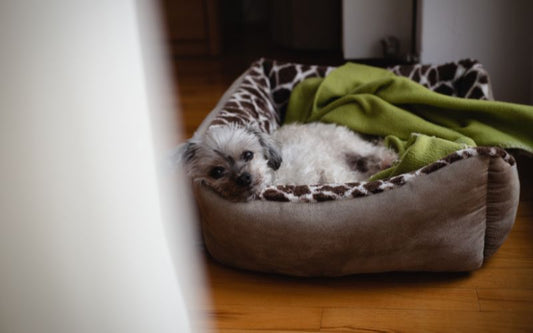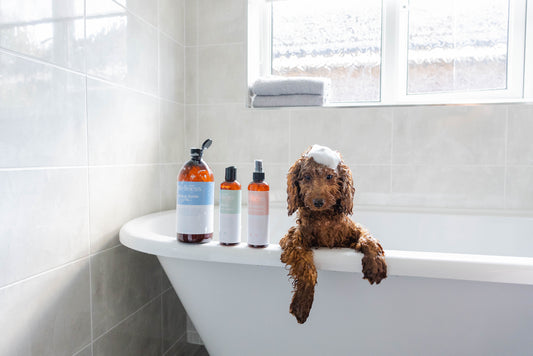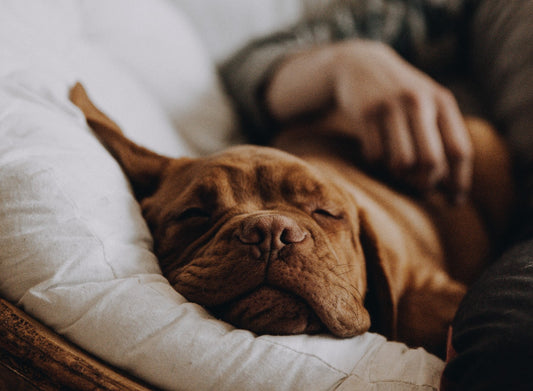Top 10 best dog breeds for first time owners
Adding a four-legged friend to your family for the first time is so exciting!
However, dog ownership isn't something you should jump into lightly. Time should be taken to consider multiple factors before committing to your new dog.
We've broken down some of the best breeds that we think would be suitable for first time owners and families:
- Golden Retriever
- Labrador
- Bernese Mountain Dog
- Yorkshire Terrier
- Boxer
- Springer Spaniel
- Pomeranian
- Whippet
- Bichon Frise
- Rescue Dog
Golden Retriever

If you looked up ‘family dog’ in the dictionary, next to it should be a picture of a Golden Retriever. Affectionate, loyal and eager to learn, they are an ideal dog for first time owners, as long as you’ve got the space and don’t mind a little bit of regular grooming.
A very active breed, they need an outlet for their energy otherwise they can be prone to boredom and develop unwanted habits, so daily walks and exercise are essential.
- Life expectancy: 10 - 12 years
- Size: 25 - 35kg
- Energy level: Active
- Trainability: Very smart, easily trainable
Labrador

A very similar temperament to the Golden Retriever, just with a much shorter coat requiring a lot less grooming.
Very even tempered, they are highly adaptable to most environments and ideal if you think you may want even more dogs in the future.
Requiring daily walks along with plenty of exercise and some intense activities, these dogs thrive being outside and on the go! But don’t worry, they absolutely love a snuggle on the sofa at the end of the day.
- Life expectancy: 10 - 12 years
- Size: 25 - 35kg
- Energy level: Active
- Trainability: Very smart, easily trainable
Bernese Mountain Dog

They may be pretty large, but Bernese Mountain dogs are known for their calm demeanour, as well as excessive amount of fluff!
With a heart of gold, they are a friendly and relaxed dog that requires a moderate amount of exercise. While they love going on hikes and require daily walks, they aren’t going to be running for miles.
- Life expectancy: 6 - 8 years
- Size: 30 - 55kg
- Energy level: Medium
- Trainability: Quick learners, but not too smart that they will outsmart you!
Yorkshire Terrier

Now if you’re looking for a little lap dog, look no further! A Yorkie is the perfect starter dog if you live in smaller accommodation and aren’t after a super active companion.
Still requiring a daily walk, but nothing strenuous as they’ve only got short legs, these little dogs are very affectionate and loyal to their owners. You need to start training early though as they can become very stubborn and even a bit vocal.
Yorkie’s have continually growing hair, so regular dog grooming is needed to keep them in good condition. As long as you’ve got the time and money for grooming visits, it is fairly simple to keep your Yorkie happy and healthy.
- Life expectancy: 13 - 16 years
- Size: 2.8 - 4.6kg
- Energy level: Moderate, just a basic daily walk will be enough for these little ones
- Trainability: Above average intelligence, easily trainable, big dog in a small body
Boxer

If you’re after a big loveable ball of fun, then look no further than a Boxer. These playful dogs can get pretty big, so make sure you’ve got the room for one of them running around.
Starting training early with these dogs is essential as they are high energy and prone to jumping up, so the ‘get down’ command will become your best friend.
Definitely the dog for you if you love the outdoors, they will love going on adventures with you, and then happily curl up at the end of the day with a big sloppy kiss.
- Life expectancy: 10 - 12 years
- Size: 25 - 32kg
- Energy level: Lively, high energy
- Trainability: Early consistent training is critical, but easily trainable
Springer Spaniel

The larger of the 2 most common spaniel breeds, Springers are typically more energetic than their Cocker counterparts.
Perfect for people on the go as they have boundless energy, however beware when out on walks as their prey drive can kick in and off they go!
Just like Cavalier King Charles Spaniel dogs, Springers love mental stimulation and are keen to learn - so training them is easy. But don’t worry, they may play hard but they also know how to relax hard as well.
- Life expectancy: 12 - 14 years
- Size: 18 - 25kg
- Energy level: High energy
- Trainability: Obedient, keen to learn and eager to please, enjoys mental stimulation
Pomeranian

Very similar to the Yorkie, these little dogs are the perfect companion for those after a lap dog. Most often thrive and bond well with a single owner, they can still adapt to multi person households.
You’ll need to set some training boundaries early on to ensure your Pom doesn’t become stubborn and vocal. Basic daily exercise is all they will need, and they will love a bit of playtime with you.
Thankfully not as high maintenance as they look, their coats will just need some regular brushing to keep a tangle free, soft and shiny dog coat.
- Life expectancy: 12 - 16 years
- Size: 1.9 - 3.5kg
- Energy level: Moderate, daily walks and playing with toys
- Trainability: Easy to train, don’t normally want to stray far
Whippet

Despite being bred for racing, these guys are notorious couch potatoes so make sure you’ve got room on your sofa. Loveable, friendly and not too large, they are great for first time owners.
They are not the most intelligent of dogs, so getting the training in early is ideal, and load up on the treats as they are very food driven. Not the most reliable off-lead, getting a good recall will be the challenge, but once you’ve mastered it these dogs will love a good sprint.
These skinny dogs will most likely need a doggy coat or jacket in the colder months to keep them warm, and you may find that they will say ‘no thank you’ to a walk if the weather is too bad. They would much prefer to curl up with you by the fire.
- Life expectancy: 12 - 15 years
- Size: 6.8 - 19.1 kg
- Energy level: Moderate
- Trainability: Average intelligence, will train well with lots of treats
Bichon Frise

Bichon’s are the perfect all round companion dog for first time owners. Gorgeous little cotton balls, these guys are easy going and highly adaptable to most environments.
Easily trainable and not overly energetic, just daily basic exercise is all they will need. They will happily snuggle on the sofa, or accompany you for a walk around town.
A Bichon’s coat can be left longer and shaped, but this will require a rigorous brushing routine. If you don’t fancy that, you can regularly take them to the groomers and keep their coats short.
- Life expectancy: 14 - 15 years
- Size: 4 - 7kg
- Energy level: Can have little bursts of high energy, but happy to relax and potter around
- Trainability: Easy to train
Rescue

If you aren’t sure on what breed suits you best, or are more open to the individual dog than a certain breed, you can visit your local dog shelter and talk to them.
Creating a list of ‘wants’ and ‘don’t wants’ on things such as size, grooming requirements and energy levels can really help them match you up with the perfect dog.
You can ask specifically about foster dogs. These will have been in foster homes for a period of time and their ‘owners’ will be honest with you about their temperament and behaviours as they want the dogs to go to the right homes.
Best dog breeds for families
Wanting to add a dog to the family? The benefits of children growing up with dogs are endless, from increased activity levels to a happier mindset.
But there are lots of things to think about before jumping in;
- How much space do you have? Indoor and outdoor?
- How old are your children?
- How much money can we dedicate to the dog? (Food, grooming etc)
- How much time can we spend on the dog? (Training, walking etc)
Avoiding breeds known for being stubborn and aloof as kids will not know boundaries right away, and taking the age of your children into consideration. You will not want a huge bouncy dog around toddlers, but then you may not want a small delicate dog either around playful kids.
Child friendly dog breeds:

Boston Terrier
- Small but sturdy dogs, these are an ideal size to have around children. They are lovable and goofy and absolutely love playtime so would make a great companion.
Border Terrier
- A hypoallergenic breed, so ideal for allergy sufferers or those avoiding shedding dogs. While being on the smaller side, Border Terriers are amazing with small children, full of love and adventure. Warning: they love to dig!
Cocker Spaniel
- Smaller and less energetic than Springers, these little guys are a bit more laid back and will equally enjoy playtime with the kids, followed by curling up with them.
Staffordshire Bull Terrier
- Known for their love of children, Staffies coined the nickname ‘Nanny dog’. They can be boisterous so careful around little children, but one of the most affectionate, loyal and loving breeds.
Beagle
- Another small and sturdy breed, these little dogs were bred to hunt as a pack so companionship is second nature to them. They love any interactive play so will get on perfectly with slightly older children.
Is it a good idea to get a dog with a baby or toddler?
There are a lot of things to take into consideration before getting a dog when you’ve got a very little child in the house.
You may want to avoid the larger high energy dogs, but that’s not to say you can need to discount bigger dogs. Retrievers and labradors are known to have a soft mouth and bite inhibition so great with smaller children, while are also known to tolerate a bit of hair pulling and hugging.
Also, avoiding much smaller dogs such as Chihuahuas and miniature Poodles is advised as they can be a lot more fragile and frightened of boisterous children.
As a general rule of thumb, if you have children under the age of 6, it is best to try and adopt a dog over the age of 2. Puppies require a lot more time and energy and can be prone to more rough play which you want to avoid around children.
As long as you really take everything into consideration, the benefits of getting a dog with smaller children are amazing.
- Reduce stress and anxiety
- Encourage an active and healthy life
- Help your child learn to make friends
- Learn empathy and compassion
- Less prone to allergies
Plus, they just make children happy!
Choosing the right dog
Choosing the right dog for your situation is important. Diving in too fast before thinking about it enough can lead to an unhappy dog, an uncomfortable home for you, and in the end, potentially rehoming your new addition.
If you are still unsure of what breed you think would be best suited to you, there are lots of online resources to look at, as well as quizzes to narrow down your search. Try out this dog breed selector quiz.
Factors to consider before getting a dog
It is best to create a list of everything you are looking for in a dog and doing your research before jumping into ownership. After you've thought about the best type of dog breed, you should make a list of the different puppy essentials that you'll need to budget for.
Things to consider:
- Size
- Grooming requirements
- Exercise needs
- Cost (food, vets bills)
- Gender
- Temperament/traits
Make sure you take into account your long term plans and resources, as your new family member can be around for up to 15 years.
The importance of being ready for a dog is paramount, you can check our previous blog on lockdown dogs and and make sure you have asked yourself all the questions needed before committing.
Check out our other blogs as well on how to show kindness to your new dog, and even some tips on how to deal with separation anxiety once your new family member has arrived home.


